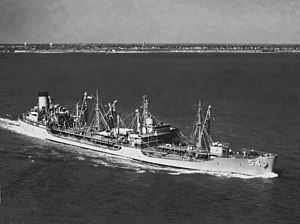
USS Miller (DD-535) was a World War II-era Fletcher-class destroyer in the service of the United States Navy, named after Medal of Honor recipient Acting Master's Mate James Miller.

USS Owen (DD-536), was a Fletcher-class destroyer of the United States Navy.

USS Guadalupe (AO-32), a Cimarron-class fleet replenishment oiler that served in the United States Navy, it was named for the Guadalupe River in Texas.

USS Cimarron (AO-22) was a Cimarron-class oiler serving with the United States Navy and the second ship to be named for the Cimarron River in the Southwestern United States. She was launched 7 January 1939 by Sun Shipbuilding and Drydock Company, Chester, Pennsylvania; sponsored by Mrs. William D. Leahy; and commissioned 20 March 1939.

USS Nantahala (AO–60), the second ship of this name, was laid down under Maritime Commission contract by Bethlehem Sparrows Point Shipyard, Inc., Sparrows Point, Maryland, on 31 October 1943. Launched on 29 April 1944; sponsored by Miss Mary Louise Reed; delivered to the Navy 19 June 1944; and commissioned the same day.

USS Lowry (DD-770), an Allen M. Sumner-class destroyer, is the only ship of the United States Navy to be named for Reigart Bolivar Lowry, who served in the Mexican–American War and was a member of Commodore Matthew C. Perry's expedition to Japan in 1855. He served with distinction in the American Civil War, capturing New Orleans and in the first attack on Vicksburg.

USS Hailey (DD-556) was a Fletcher-class destroyer of the United States Navy.

USS Caperton (DD-650) was a Fletcher-class destroyer of the United States Navy, named for Admiral William B. Caperton (1850–1941).

The third USS Merrimack (AO-37) (ex-Caddo) was one of five Kennebec-class fleet oilers built during World War II for service in the United States Navy. She also service in the Cold War. She was named after the Merrimack River in Massachusetts and New Hampshire.

USS Platte (AO-24) was a Cimarron-class oiler serving with the United States Navy, named for the 1836 Platte Purchase that included the Platte Rivers in Iowa, Missouri and Nebraska. Her memorial in Platte County, Missouri honors all four rivers that share the name recorded by Lewis and Clark in 1803.

USS Kaskaskia (AO-27) was a Cimarron-class fleet replenishment oiler serving in the United States Navy, named for the Kaskaskia River in Illinois.

USS Kankakee (AO-39) was a Kennebec-class fleet oiler of the United States Navy. The ship was built as SS Colina by Bethlehem Steel Co., Sparrows Point, Maryland, launched on 24 January 1942, sponsored by Mrs. D. A. Little, acquired for the Navy on 31 March through the Maritime Commission from her owner, Socony-Vacuum Oil Company, New York City, and commissioned as Kankakee at Norfolk, Virginia, on 4 May.

The second USS Monongahela (AO-42) was a Kennebec-class oiler in the United States Navy which saw service during World War II and the Korean War. She was the second U.S. Navy ship named for the Monongahela River in West Virginia and Pennsylvania.

USS Tallulah (AO-50), originally named the SS Valley Forge, was a Type T2-SE-A1 Suamico-class fleet oiler of the United States Navy.

USS Millicoma (AO-73) was a United States Navy fleet oiler which served in the Pacific Theatre during World War II, winning eight battle stars for her dangerous work. Post-war she was recommissioned and was placed under the control of the MSTS with a civilian crew until finally assigned for disposal in 1987.

The USS Manatee (AO-58)—the second vessel of the United States Navy to bear the name—was a Cimarron-class fleet replenishment oiler named for a river in Florida. Cimarron-class oilers were named after American rivers in the southern United States.
USS Heed (AM-100) was an Auk-class minesweeper built for the United States Navy during World War II. She earned five battle stars for her World War II service. She was recommissioned during the Korean War. She was placed in reserve in 1954 and remained there until struck from the Naval Vessel Register in 1967.

USS Niobrara (AO-72) was a T3 Kennebec-class oiler constructed for the United States Navy during World War II. She was the only U.S. Navy ship named for the Niobrara River in Nebraska.

USS Chipola (AO-63) was a Cimarron-class fleet oiler acquired by the U.S. Navy during World War II. She served her country primarily in the Pacific Theater of Operations, and provided petroleum products where needed to combat ships. For performing this dangerous task in combat areas, she was awarded three battle stars during World War II and thirteen campaign stars during the Vietnam War.

USS Silverstein (DE-534) was a John C. Butler-class destroyer escort in service with the United States Navy from 1944 to 1947 and from 1951 to 1958. She was sold for scrapping in 1973.




















